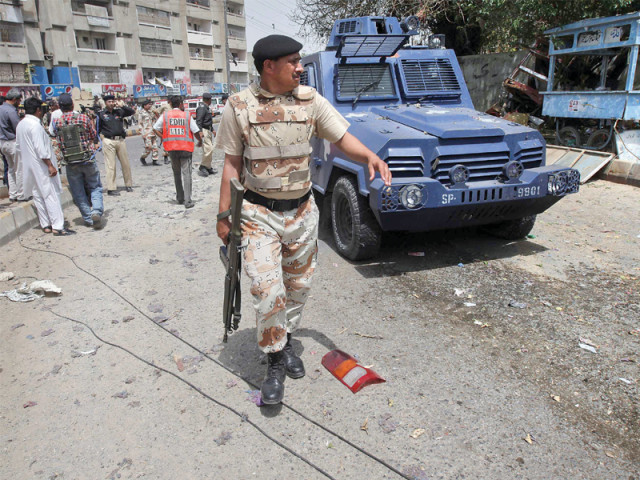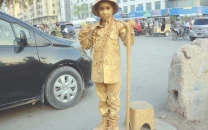Coffins on wheels?: ‘APCs were not substandard, they were not the right type’
Gangsters targeted vehicles’ vulnerable spots, says police official.

About 14 dust-coated armoured personnel carriers (APCs) stand in the courtyard of the Garden Police Headquarters, awaiting their turn to go back to their manufacturer, Heavy Industries Taxila (HIT), for repair. A debate about the quality of these vehicles and utility in the heavily weaponised city emerged after gangsters managed to damage the 18 APCs used in the May 2012 Lyari operation with rockets, hand grenades and anti-aircraft guns.
There were reports that Civil Lines SHO Fawad Ahmed was killed inside one of the APCs used in the Lyari operation. HIT refuted these claims, saying that no bullets penetrated the body of the APCs. So how exactly did the SHO lose his life? The answer might lie with a police constable Aslam Yaqoob, who was inside the same APC as SHO Fawad Ahmed.
His account shockingly depicts how the gangsters targeted the vehicle’s vulnerable spots with surgical precision and rendered it useless. “As we were travelling down Afshani lane, the gangsters volleyed two rockets at the front of the APC. As a result, the driver lost control of the vehicle, which swerved right into a nearby donkey-cart and flipped onto its side,” Yaqoob told The Express Tribune.
In congruence with HIT’s claims, Yaqoob said that no bullet had managed to penetrate the aluminum body of the APC. But the shrewd gangsters aimed at the damaged windscreen with anti-aircraft guns as well as sniper rifles and lobbed a hand grenade at it. The windscreen could not withstand the heavy fire and broke, leaving the passengers vulnerable and exposed. It was then that gangster’s arsenal hit the policemen, including SHO Ahmed, who died when fragments from the grenade got lodged inside his neck. “If you are sitting inside an APC but somebody keeps firing rockets at it, the vehicle will eventually be ruined,” said Yaqoob. “They fired at us from a distance of around 40 feet and the ambush was so overwhelming that we didn’t get a chance to retaliate. There might have been fewer casualties if backup had arrived on time to help us out of the situation.”
Pricey rides
There are about 90 APCs in entire province, including 17 ‘Talha’ models, the chain-mounted variety. About 30 of them are being used by the Karachi police and its different units, including the Crime Investigation Department, Special Investigation Unit and Anti-Violent Crime Cell. A wheeled variety of B-6 level costs Rs20 million each while a B-7 grade APC costs about Rs54 million per piece.
SP gives a clarification
The Sindh police will send the damaged vehicles to HIT for repair in batches of four. The first batch has already been sent off. The law enforcers have also returned four new APCs which were recently purchased from HIT. Some newspapers reported that the move highlighted the fact that the vehicles were of substandard quality. Assistant general inspector of police, Qamar Raza Jiskani, who works at the Sindh motor department, refuted these reports. “We have indeed returned four APCs to the manufacturers, but the reason behind this move was misreported,” he told The Express Tribune. “Given the type of ammunition being used by gangsters in Karachi, the APCs that are already operational are prone to damage. But we can’t upgrade or return these,” he said. SP Jiskani added that the police had decided that the four recently acquired APCs should be returned for a model that can withstand the kind of weapons used by rogue groups in Karachi. “This entails upgrading the protection level from B-6 to the higher B-7 level.”
He said that the protection level of the B-6 APCs is low as compared to B-7 type. “We need the vehicles to be upgraded to the B-7 level to deal with the situation in Karachi. There are two types of APCs. One has an aluminum body while the other is made of steel,” he explained. “We use aluminum APCs in the city because bullets become embedded in its body. The ones which have a steel body are used in rural areas because bullets simply ricochet off it – this could prove to be dangerous in urban settings.”
The entire focus of the debates surrounding the APCs has been the upgrading of the body armour from the B-6 level to the more hardy B-7 type. But the question is that even if 54 million rupees are spent on an APC to upgrade it to the B-7 protection level, would it be able to defeat the criminals, who have devised sophisticated strategies to take them down?
Published in The Express Tribune, July 31st, 2012.



















COMMENTS
Comments are moderated and generally will be posted if they are on-topic and not abusive.
For more information, please see our Comments FAQ